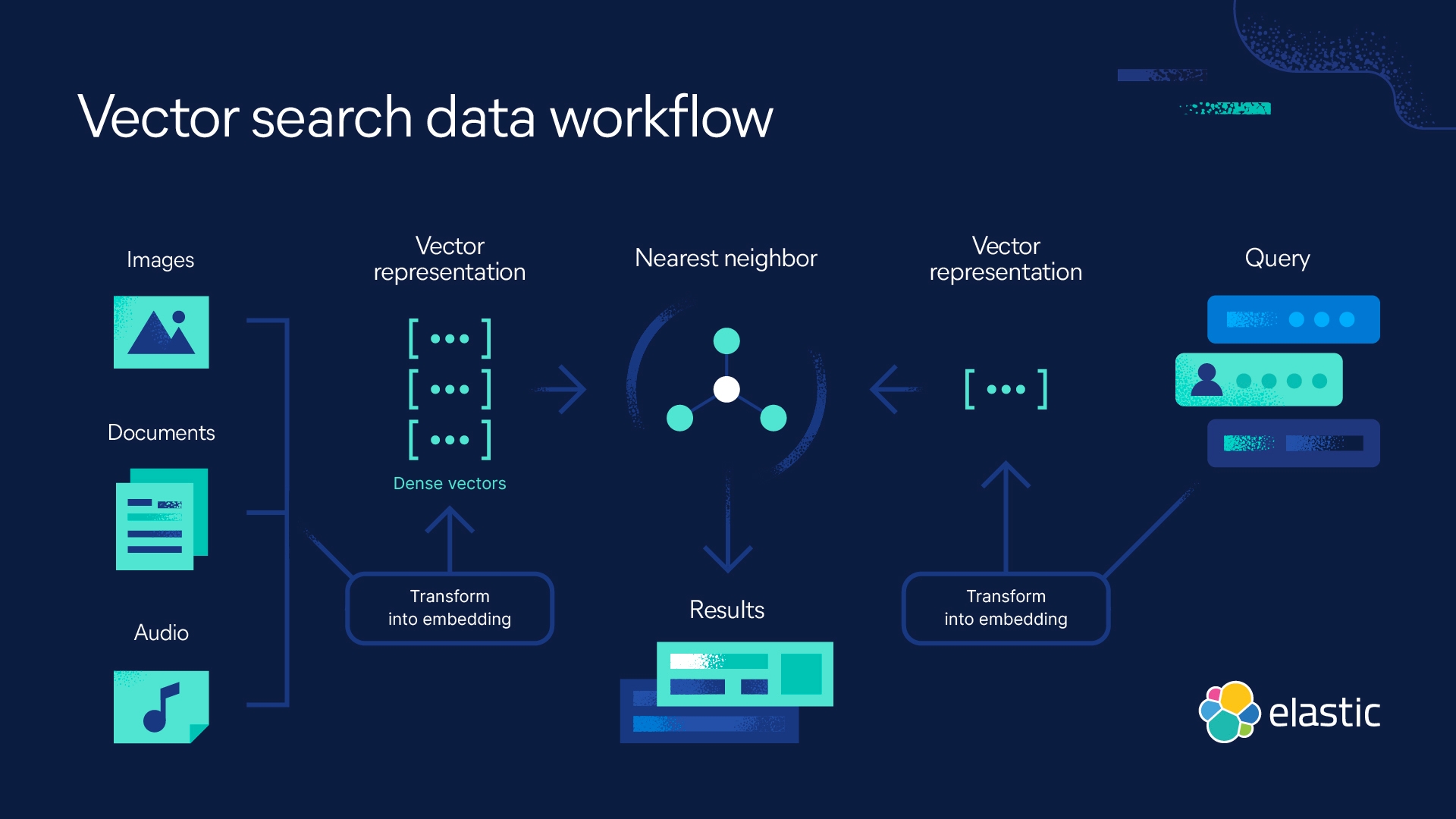The benefits of vector search — and 5 reasons IT leaders need it to improve search experiences

Frequent interactions with high quality search engines, like Google and Amazon, have increased customer expectations for fast and relevant search. Vector search (also known as semantic vector search) leverages deep learning and machine learning to capture meaning and context of data.
The benefits of vector search
Vector search can enhance your company’s search experience and deliver a wide range of benefits, including:
- Delivering highly relevant results to your users with less effort
- Returning fast search results, even on large and varied data
- Enabling new classes of search for text, image, and audio
- Serving more accurate product recommendations, FAQ answers, and even personalization directly to customers
For technology leaders, learn more about vector search and how it can help you not only meet, but exceed customer expectations. It can help transform your search experience and help you meet your business goals.
So, what is vector search?
Vector search transforms text, audio, and images into numeric representations and leverages deep learning and machine learning (ML) to interpret the meaning, intent, and context of these representations to serve up much more relevant search results.

Semantic vector search enables new classes of search
We all expect highly relevant search results no matter how we write a search query. But even abstract keyword searches still require a high degree of natural language understanding and blazing fast response time. Add to this a desire for a broader range of search experiences — from image search for visual shopping, audio search like Amazon Alexa, or in-app visual recommendations like Pinterest — it becomes clear search needs to adapt to how we look for things.
Semantic vector search technology is better at understanding human language and can interpret different data formats, like visual, audio, and unstructured text. It acts as a bridge between unstructured data and interpretation of a user's intent (not just their keywords) to deliver a powerful experience that not only meets, but can potentially exceed expectations.
Elastic is a feature-rich environment for creating a variety of search solutions. The ability to combine semantic search aspects into solutions is key for search evolution and Elastic is well-positioned for it.
Prem Malhotra, Director, ML/AI & Search at Cisco
Vector search can drive real revenue
Vector search is already being used widely to improve relevance, boost sales, and drive revenue.
How Spotify leverages vector search
Spotify hasn’t always used vector search for podcasts. In the recent past, Spotify relied mostly on keyword term matching. This search method would return results containing everything that has the query keywords in its indexed metadata. But users don't always type exactly what they want. They often don't know the terms to use or express themselves in very different ways.
Vector search enabled Spotify to deliver more relevant content with significantly less effort by matching semantically correlated results, instead of needing exact word matches. For example, a search for “electric cars climate impact” now returns results for “electric cars and ecology” or “environmental impact of electric vehicles.” Semantic vector search can identify the similarity of the term ‘climate’ and ‘ecology’ or ‘electric car’ and ‘electric vehicle’ without the need for search engineers or users to do anything.
How Home Depot delivers more relevant search results with semantic vector search
Home Depot has a stock list of more than two million products, including highly specialized tools. Customers struggled to find the right tool to match their needs, often leading to multiple attempts and frustration, and increased returns for Home Depot. Implementing semantic vector search allowed them to deliver more relevant results to their customers by combining vector and text search.
For example, when a customer searches the keyword “roofing supplies,” it will also return shingles. This has alleviated the Home Depot search team from needing to load creative product descriptions, regional variations, and misspelled keywords into their search index.
Learn more about natural language processing (NLP), the technology behind vector search.
Vector search can be implemented, no matter your company size
Vector search can be used for a wide range of use cases. No matter your company’s size or how much data you have, vector search can help you improve your search experience, if you use the right tool. Using vector search can help you achieve:
Better relevance to drive better engagement
Serving more helpful results to users leads to more engagement on your website site and apps. Keyword based searches do not perform well when words may have multiple meanings, or are ambiguous. Semantic vector search enables more precise results even over very large data sets. It leverages semantic search technology to return relevant results, even when users don't know the exact keyword.
Faster performance, even on large data volumes
Vector search can be combined with traditional search scoring for a better search experience. This offers more relevant results quicker even on larger data sets. Algorithms like nearest neighbor and approximate nearest neighbor leverage efficient methods to process and rank large volumes of documents for search queries.
Expanded classes of search
Enable new types of searches like image or audio with a vector search engine — known as vector databases, semantic, or cosine search. For example, an ecommerce business can allow site visitors to upload a picture of a product like a dress and search for similar items. This creates engagement and a simpler way for some shoppers to search.

Let's say an employee is looking for leadership courses. With vector search in Elastic Enterprise Search, we can better understand the user’s intent and return courses that are tailored to their industry, organization, and role.
Jon Ducrou, Senior Vice President of Engineering, Go1
Semantic vector search interprets the context, intent, and meaning of searches so your customers don’t have to
Semantic vector search enables greater relevance by determining the intent, meaning, and context of a query. This is done by converting a search query into a meaningful numerical representation, or vector, that's compared to a dataset to measure similarity and find the most relevant results. To make informed decisions, technology leaders need a high level technical understanding of vector search, and there are three components to know.

1. Turn text to numbers with vector embeddings: Any algorithm needs numbers to work. Vectors convert keyword text to numerical data that capture the linguistic content of the text. For example, two widely used models — Word2Vec and BERT — were created by analyzing large samples of language data to understand the frequency of co-occurrence and relationship between words. So the vector for "Canada" might be close to "France" in one direction, and close to "Toronto" in another. These models enable us to transform keywords, sentences, or paragraphs into vector embeddings that can be compared.
2. Search faster with better search algorithms: Another essential component of vector search is a high performance algorithm to compare and return relevant results quickly even when comparing billions of documents. This can include approximate nearest neighbor (ANN), which is a form of proximity search, to find the results in a given set that are closest (most similar) to a given query. ANN runs efficiently, scaling to large datasets while maintaining performance. To enhance query speed, a graph is generated to navigate all the data points and quickly map a vector to the most similar, matching results.
3. Discover similar results with distance metrics: Vectors make it possible to essentially assign each keyword a different set of coordinates that can be used to assess the similarity between a query and a document by measuring the distance of how near search terms appear together. The shorter the distance between vectors, the more similar the content. Measures such as cosine similarity are used to determine the similarity between two sequences of numbers and vectors to return the most similar results.
How to get all the benefits of vector search engines, fast
While some solutions may promise an enhanced search experience, Elastic is known as the leader in search-powered technology. Our customers are able to quickly experience benefits using the Elastic platform and continuously refine their search experience with new and innovative features, like vector search.
Why Elastic for vector search?
At Elastic, we offer an easy deployment path to implement vector search and hybrid searches so you can start enhancing your search experience right away. It’s because our vector search combines multiple approaches to search relevance, giving you all the advantages of Elastic — performance, simplicity and customization — with the power of vector search.
You can deploy vector search to tackle the biggest gaps in your search experience.
Elastic is faster on query performance for large numbers of documents. To enhance query speed, Elastic uses a graph that is generated to navigate all the data points and quickly map a vector to the most similar, matching results. This approach to vector similarity search uses an ANN algorithm called Hierarchical Navigable Small World (HNSW). To accelerate query performance, multiple layer HNSW is supported, allowing you to traverse the graph quicker. The new layers optimize the query route as each additional higher layer has fewer data points, requiring fewer hops between data points over a larger distance to find the nearest neighbor.
Elastic provides an easy, integrated end-to-end solution. As we discussed earlier, semantic vector search requires the input of vector embeddings to determine similarity. Most solutions require an external process to generate vector embeddings, for example, for text that may be a deep neural network, but not Elastic. The advantage of Elastic's vector search is how easy it is to create support for vector embeddings.
This is through the dense vector field type, which stores dense vectors of float values and can be used to quickly find similar results with Elastics kNN search API. This simplifies the implementation and allows you to more easily generate vectors. Teams can immediately experience value. Also, you can leverage Elastic to distribute, compute, and scale as vectors, improving performance and lowering costs.
Elastic works your way — customize it to your needs. Elastic supports PyTorch, which gives you complete control to deploy your own model. You can customize it for your specific needs or industry to provide a competitive advantage. Elastic also offers out-of-the box models through HuggingFace for a quick-start option that leverages a growing community of leading language models.
Better search is good for your business
Growing customer demand makes offering a great search experience a must have. Fortunately semantic vector search is an evolutionary technology that delivers on the promise of an exceptional search experience. Whether its new types of searches, faster results, greater relevance, or personalization — Elastic can help you deliver. To continue your journey, learn how to really make an impact with vector search using our technical blog.